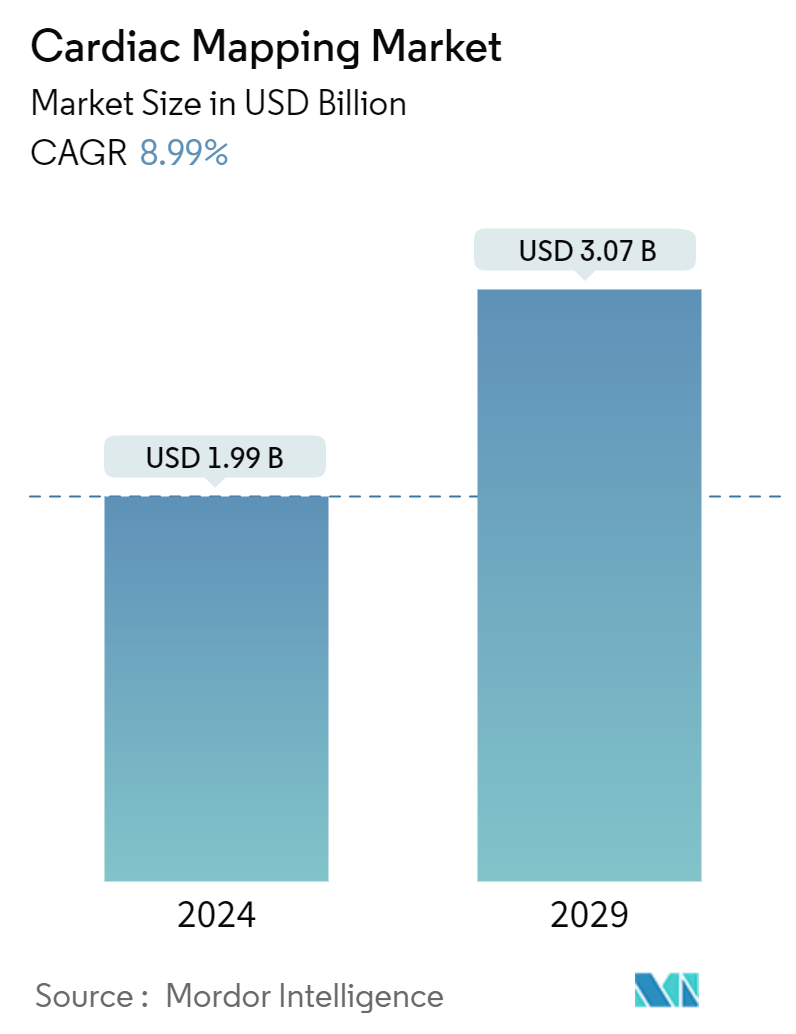Market Size of Cardiac Mapping Industry

| Study Period | 2019 - 2029 |
| Market Size (2024) | USD 1.99 Billion |
| Market Size (2029) | USD 3.07 Billion |
| CAGR (2024 - 2029) | 8.99 % |
| Fastest Growing Market | Asia-Pacific |
| Largest Market | North America |
| Market Concentration | Low |
Major Players
*Disclaimer: Major Players sorted in no particular order |
Cardiac Mapping Market Analysis
The Cardiac Mapping Market size is estimated at USD 1.99 billion in 2024, and is expected to reach USD 3.07 billion by 2029, growing at a CAGR of 8.99% during the forecast period (2024-2029).
Factors such as a rise in cardiac diseases and manufacturers' novel technological innovations in cardiac mapping devices are expected to drive market growth over the forecast period. As more individuals are diagnosed with coronary artery disease, there is a greater demand for precise diagnostic tools and technologies to assess the condition of the heart. For instance, as per the October 2022 update from the Center for Disease Control and Prevention (CDC), about 20.1 million adults aged 20 and older were diagnosed with coronary artery disease (about 7.2%) in the United States. Hence, with the high number of cardiac complications, the demand for cardiac mapping is expected to increase, boosting market growth over the forecast period.
Similarly, as per the BHF Global CVD Factsheet 2022, around 550 million people worldwide had heart and circulatory diseases in 2022. Thus, cardiac mapping plays a vital role in this process by providing detailed information about the heart's electrical activity and identifying abnormal rhythms or areas of concern. This is expected to further increase the demand for cardiac mapping, boosting market growth over the forecast period.
Product launches, strategic acquisitions, and partnerships by key players are further expected to increase product availability and competition in the market. For instance, in January 2022, Medtronic PLC entered a definitive agreement to acquire Affera Inc. at USD 925 million. Affera designs and manufactures cardiac mapping, navigation systems, and catheter-based cardiac ablation technologies. Similarly, in September 2022, Johnson & Johnson MedTech's subsidiary, Biosense Webster, unveiled its latest innovation, the Octaray mapping catheter. Thus, due to the rise in product approvals, launches, and technological advancements in cardiac mapping, the market studied is expected to grow significantly over the forecast period.
Therefore, factors such as the growing incidence of cardiac complications and manufacturers focusing on acquisition, approvals, and technological advancements for cardiac mapping are expected to fuel the market's growth during the forecast period. However, the lack of skilled electrophysiologists is likely to hinder the market's growth.
Cardiac Mapping Industry Segmentation
As per the scope, cardiac mapping is an electrophysiology study that aims to understand the cause of heart rhythm problems like arrhythmia. Mapping the heart's electrical activity is critical for diagnosing and treating heart disease.
The cardiac mapping market is segmented by type, indication, and geography. By type, the market is segmented into contact cardiac mapping systems and non-contact cardiac mapping systems. By indication, the market is segmented into atrial fibrillation, atrial flutter, and other indications. By geography, the market is segmented into North America, Europe, Asia-Pacific, the Middle East and Africa, and South America. The market report also covers the estimated market sizes and trends for 17 countries across major global regions. The report offers the value (USD) for the above segments.
| By Type | |
| Contact Cardiac Mapping Systems | |
| Non-contact Cardiac Mapping Systems |
| By Indication | |
| Atrial Fibrillation | |
| Atrial Flutter | |
| Other Indications |
| By Geography | ||||||||
| ||||||||
| ||||||||
| ||||||||
| ||||||||
|
Cardiac Mapping Market Size Summary
The cardiac mapping market is poised for significant growth, driven by the increasing prevalence of cardiac diseases and advancements in diagnostic technologies. As the incidence of coronary artery disease rises, there is a growing demand for precise diagnostic tools to assess heart conditions. This demand is further amplified by the global prevalence of heart and circulatory diseases, necessitating detailed information about the heart's electrical activity. The market is also witnessing a surge in product launches, strategic acquisitions, and partnerships among key players, enhancing product availability and competition. These developments, coupled with technological innovations in cardiac mapping devices, are expected to propel market growth over the forecast period.
The atrial fibrillation segment is a major contributor to the market's expansion, driven by its high prevalence and the increasing need for effective mapping in treatment. Technological advancements, such as 3D electroanatomic mapping and high-definition mapping, have significantly improved the safety and efficacy of ablation procedures, further boosting market growth. North America is anticipated to hold a substantial market share due to increased healthcare expenditures, a high burden of cardiac diseases, and a rise in product approvals. The region's market growth is supported by initiatives aimed at improving cardiac care and the proliferation of technological advancements. Key players in the market are focusing on strategic initiatives to enhance their global presence, contributing to the market's fragmented yet competitive landscape.
Cardiac Mapping Market Size - Table of Contents
-
1. MARKET DYNAMICS
-
1.1 Market Overview
-
1.2 Market Drivers
-
1.2.1 Increasing Incidence of Cardiovascular Complications
-
1.2.2 Rise in Technological Advancements in Cardiac Mapping Systems
-
-
1.3 Market Restraints
-
1.3.1 Lack of Skilled and Experienced Electrophysiologists
-
-
1.4 Porter's Five Forces Analysis
-
1.4.1 Threat of New Entrants
-
1.4.2 Bargaining Power of Buyers/Consumers
-
1.4.3 Bargaining Power of Suppliers
-
1.4.4 Threat of Substitute Products
-
1.4.5 Intensity of Competitive Rivalry
-
-
-
2. MARKET SEGMENTATION (Market Size by Value - USD)
-
2.1 By Type
-
2.1.1 Contact Cardiac Mapping Systems
-
2.1.2 Non-contact Cardiac Mapping Systems
-
-
2.2 By Indication
-
2.2.1 Atrial Fibrillation
-
2.2.2 Atrial Flutter
-
2.2.3 Other Indications
-
-
2.3 By Geography
-
2.3.1 North America
-
2.3.1.1 United States
-
2.3.1.2 Canada
-
2.3.1.3 Mexico
-
-
2.3.2 Europe
-
2.3.2.1 Germany
-
2.3.2.2 United Kingdom
-
2.3.2.3 France
-
2.3.2.4 Italy
-
2.3.2.5 Spain
-
2.3.2.6 Rest of Europe
-
-
2.3.3 Asia-Pacific
-
2.3.3.1 China
-
2.3.3.2 Japan
-
2.3.3.3 India
-
2.3.3.4 Australia
-
2.3.3.5 South Korea
-
2.3.3.6 Rest of Asia-Pacific
-
-
2.3.4 Middle East and Africa
-
2.3.4.1 GCC
-
2.3.4.2 South Africa
-
2.3.4.3 Rest of Middle East and Africa
-
-
2.3.5 South America
-
2.3.5.1 Brazil
-
2.3.5.2 Argentina
-
2.3.5.3 Rest of South America
-
-
-
Cardiac Mapping Market Size FAQs
How big is the Cardiac Mapping Market?
The Cardiac Mapping Market size is expected to reach USD 1.99 billion in 2024 and grow at a CAGR of 8.99% to reach USD 3.07 billion by 2029.
What is the current Cardiac Mapping Market size?
In 2024, the Cardiac Mapping Market size is expected to reach USD 1.99 billion.

